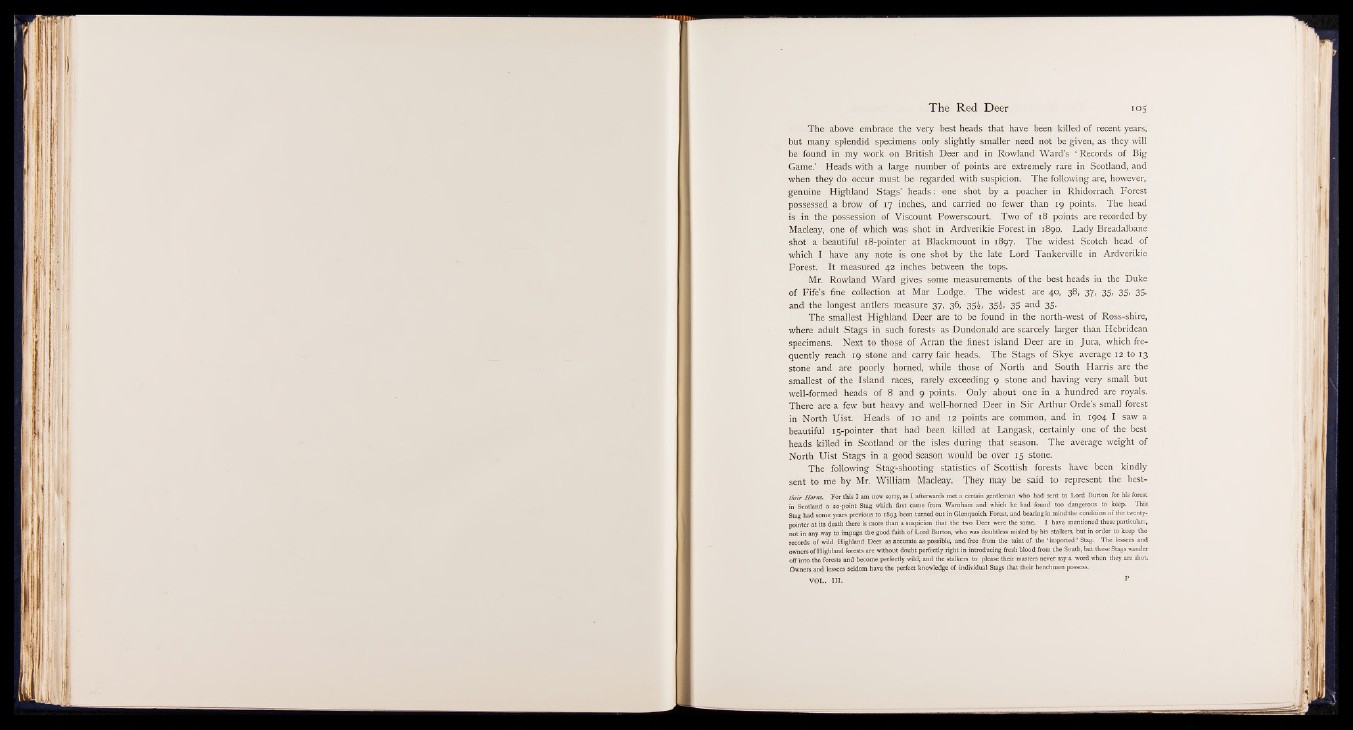
The above embrace the very best heads that have been killed of recent years,
but many splendid specimens only slightly smaller need not be given, as they will
be found in my work on British Deer and in Rowland Ward’s ‘ Records of Big
Game.’ Heads with a large number of points are extremely rare in Scotland, and
when they do occur must be regarded with suspicion. The following are, however,
genuine Highland Stags’ heads: one shot by a poacher in Rhidorrach Forest
possessed a brow of 17 inches, and carried no fewer than 19 points. The head
is in the possession of Viscount Powerscourt. Two of 18 points are recorded by
Macleay, one of which was shot in Ardverikie Forest in 1890. Lady Breadalbane
shot a beautiful 18-pointer at Blackmount in 1897. The widest Scotch head of
which I have any note is one shot by the late Lord Tankerville in Ardverikie
Forest. It measured 42 inches between the tops.
Mr. Rowland Ward gives some measurements of the best heads in the Duke
of Fife’s fine collection at Mar Lodge. The widest are 40, 38, 37, 35, 35, 35,
and the longest antlers measure 37, 36, 35L 35!, 35 and 35.
The smallest Highland Deer are to be found in the north-west of Ross-shire,
where adult Stags in such forests as Dundonald are scarcely larger than Hebridean
specimens. Next to those of Arran the finest island Deer are in Jura, which frequently
reach 19 stone and carry fair heads. The Stags of Skye average 12 to 13
stone and are poorly horned, while those of North and South Harris are the
smallest of the Island races, rarely exceeding 9 stone and having very small but
well-formed heads of 8 and 9 points. Only about one in a hundred are royals.
There are a few but heavy and well-horned Deer in Sir Arthur Orde’s small forest
in North Uist. Heads of 10 and 12 points are common, and in 1904 I saw a
beautiful 15-pointer that had been killed at Langask, certainly one of the best
heads killed in Scotland or the isles during that season. The average weight of
North Uist Stags in a good season would be over 15 stone.
The following Stag-shooting statistics of Scottish forests have been kindly
sent to me by Mr. William Macleay. They may be said to represent the besttheir
Horns. For this I am now sorry, as I afterwards met a certain gentleman who had sent to Lord Burton for his forest
in Scotland a 20-point Stag which first came from Wamham and which he had found too dangerous to keep. This
Stag had some years previous to 1893 been turned out in Glenquoich Forest, and bearing in mind the condition of the twenty-
pointer at its death there is more than a suspicion that the two Deer were the same. I have mentioned these particulars,
not in any way to impugn the good faith of Lord Burton, who was doubtless misled by his stalkers, but in order to keep the
records of wild Highland Deer as accurate as possible, and free from the taint of the ‘ imported ’ Stag. The lessees and
owners of Highland forests are without doubt perfectly right in introducing fresh blood from the South, but these Stags wander
off into the forests and become perfectly wild, and the stalkers to please their masters never say a word when they are shot.
Owners and lessees seldom have the perfect knowledge of individual Stags that their henchmen possess.
VOL. III.